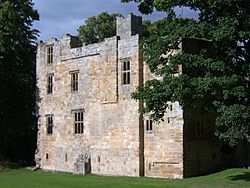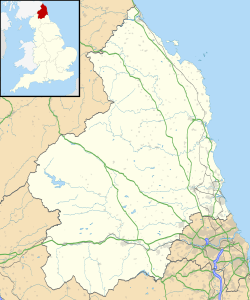Dilston Castle facts for kids
Quick facts for kids Dilston Castle |
|
|---|---|
| Northumberland, England | |

Dilston Castle, 2005
|
|
|
Location in Northumberland
|
|
| Coordinates | 54°57′54″N 2°02′20″W / 54.965°N 2.039°W |
Dilston Castle is an old castle ruin in Northumberland, England. It is near the town of Corbridge. This castle was built in the 1400s.
It is a special historic place. The government protects it as a Scheduled Ancient Monument. It is also a Grade I listed building, which means it is very important.
The castle started as a three-story tower. Sir William Claxton built it in the 15th century. It was built on the spot where an even older tower, called a pele tower, once stood.
Contents
The Radclyffe Family and Dilston Castle
In 1621, the Radclyffe family took over Dilston Castle. This happened when Edward Radclyffe married the woman who owned Dilston. The Radclyffe family was Catholic. They built a private chapel next to the castle in 1616. This chapel is also a protected historic building.
In 1622, Sir Francis Radclyffe made the tower house part of a new, bigger home. This new home became known as Dilston Hall.
Important Radclyffes
A later family member, also named Francis Radclyffe, supported the King during the English Civil War. Because of this, the government took his property, including Dilston Hall. But after the war, the property was given back to the family.
The 3rd Earl, James Radclyffe, started building a huge new mansion in 1709. He wanted to replace the old house. But this new mansion was never finished.
James Radclyffe joined a rebellion in 1715. This rebellion was called the Jacobite rising of 1715. He was found guilty of treason, which means betraying his country. He was executed in 1716. People say the ghost of his wife still haunts the castle.
His brother, Charles Radclyffe, also joined the rebellion. He escaped to France. But he returned to support another rebellion in 1745. He was caught and executed in 1746.
What Happened to the Castle After 1716?
After the 3rd Earl was executed, his property should have gone to the King. But he had arranged things so his two-year-old son, John, would inherit it. John died when he was 18.
The property then faced many legal problems. Eventually, an Act of Parliament in 1735 decided what would happen. The money from the Dilston estates would help pay for Greenwich Hospital. This hospital was a home for sailors who had served their country.
The Commissioners of Greenwich Hospital managed the estate. Dilston Hall, the big house that was never finished, was used by the hospital's manager. But in 1765, the Commissioners ordered the mansion to be torn down. Only the castle tower and the chapel were left standing.
The estate stayed with Greenwich Hospital for a long time. In 1865, it was sold to Wentworth Blackett Beaumont.
Bringing the Castle Back to Life
Work to fix up Dilston Castle began in 2001. The castle was even open to visitors for a short time in 2003.
In 2004, a lot of money was given to restore a bridge near the castle. This bridge, called The Lord's Bridge, was built in the early 1600s. Money also helped save other old buildings on the castle grounds.
Recent digs have found parts of the old Dilston Hall. They also found signs that people lived on this spot in the Middle Ages. The castle's restoration included a new roof and new floors. A new wooden staircase was built inside the castle to reach the upper levels.
The castle shares its grounds with a chapel. This chapel is also a protected historic building, just like the castle.
Dilston Castle is located on the same property as Cambian Dilston College. This college is a home and school for young adults with learning difficulties. It used to be a hospital for new mothers. But Lord Rix, whose daughter had learning difficulties, helped change it into the college it is today.


